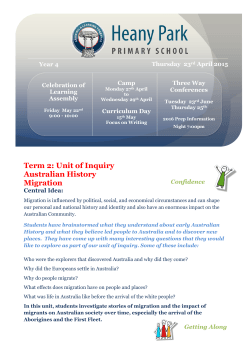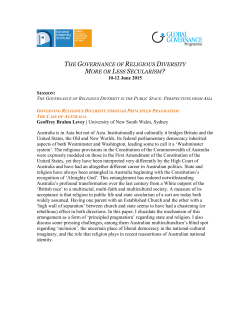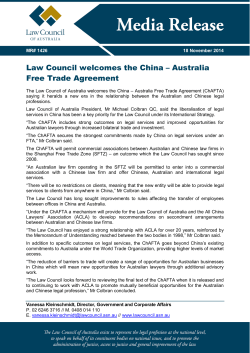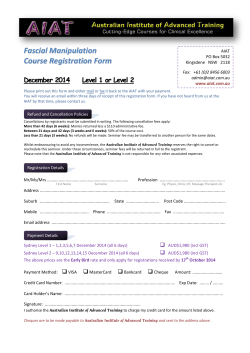
the changing roles of women 1939
5.9 The changing roles of women 1939–1945 Australian women played a more active and important role in the World War II war effort than they had during World War I. They volunteered in tens of thousands for work in traditional roles and in areas beyond those roles. Women moved into new areas of the paid workforce, taking on men’s roles in businesses, on production lines and on the land. They also took on non-combatant roles in the three branches of the military service. When Japan entered the war in December 1941, Australian participation changed from that of Britain’s ally to that of a country engaged in its own national defence. As a result, from 1942 onwards, the ‘working’ woman was visible, in demand and (briefly) had higher status than the housewife — although her role also changed (see source 5.54). SOURCE 5.54 An extract from Dorothy Hewett’s comment on women’s wartime roles I think one of the things that happened during the war was that women became the head of the family. They’d taken over all responsibility of handling the money, handling the disciplinary problems, handling what would happen to the children, making day-to-day decisions. That was an enormous change. And when the husbands came back the children in many cases had never seen their fathers, they’d never lived in the same house with them, they didn’t know who they were. They were strangers, and I think many of those children never related to those fathers again — nor the father to the children. Extract from Joanna Penglase and David Horner, When the War Came to Australia, Allen & Unwin, Sydney, 1992, p. 236. SOURCE QUESTION Explain what source 5.54 reveals about changes to women’s wartime role within the home. Voluntary work Women knitted balaclavas, gloves, jumpers and socks to provide items for the Australian Comforts Fund to send to men serving overseas. They organised entertainment for men on leave and they formed organisations to coordinate less traditional voluntary work. The Women’s Australian National Service (WANS) organised women to drive and service army vehicles, ambulances and aircraft. It also trained women in air-raid drills, first aid and basic military drills. More specialised training targeted the development of skills in shooting, signalling and mechanics. Three hundred women trained with the Women’s Emergency Signalling Corps so that male postal workers could enlist in the armed services. In 1939 Queenslander Mary Bell founded a volunteer organisation called the Women’s Air Training Corps (WATC). Famous Australian aviator, Nancy Bird Walton (1915–2009) was an important leader in this organisation (see page 138). She encouraged women aviators to join it and helped convince the government that they (the women) provided the commitment that could form the basis for the formation of the Women’s Auxiliary Australian Air Force (WAAAF). Women responded diligently to the increased need for their efforts following Japan’s 1941 entry into the war. The Auxiliary of the National Defence League of Australia made most of the camouflage netting needed to disguise military equipment and potential targets from enemy aerial surveillance. The Red Cross worked tirelessly to raise money to fund its free blood transfusion service and to provide books and toiletries for wounded men being treated in hospitals. Some women in Red Cross Aid Units and Voluntary Aid Detachments (VADs) provided medical support services in hospitals. 200 Retroactive 2 SOURCE 5.55 A photograph showing a woman checking and counting bullets in a World War II munitions factory SOURCE QUESTION Clarify what this picture shows about the nature of women’s work in World War II. munitions: weaponry, ammunition and other materials used in fighting war SOURCE 5.56 Recruitment poster for the Australian Women’s Land Army Doing ‘men’s work’ In the period 1939–1943, women’s participation in the paid workforce increased by 31 per cent. They filled the increased need for workers in traditionally ‘female’ jobs and also took on ‘men’s jobs’, replacing and freeing men to join the armed services. Women worked in factories in tasks ranging from food production to steel production. They became bus drivers and drove delivery AWM 007731 carts and vans. Japan’s entry into the war and then the fall of Singapore in 1942 created huge growth in demand for munitions. The Commonwealth Government campaigned to increase women’s involvement in this area. Prime Minister John Curtin called for the ‘extensive employment of women in industry’ and promised that their employment was ‘only for the duration of the war’. Women took on jobs making all kinds of weaponry from bullets to anti-tank shells. Universities and government laboratories employed them in optical munitions work, where they took measurements, did the complex mathematical calculations needed for lens manufacture, designed and ground lenses and tested optical instruments. They made a significant contribution to Australia’s wartime production of binoculars, bomb and gun sights, cameras, periscopes, range finders and telescopes. The Australian Women’s Land Army SOURCE QUESTION Interpret the artist’s purpose in creating source 5.56 and identify the methods used to achieve this. AWM ARTV06446 The Country Women’s Association (CWA) began organising women to do men’s farm work as early as 1939. The Commonwealth Government formally took over this task when it established the Australian Women’s Land Army (AWLA) in July 1942. Members had to be British subjects aged CHAPTER 5 | Australia and World War II 201 between 18 and 50. The farmer, not the government, paid them for their work, because they volunteered rather than officially ‘enlisted’ for service. Women could join the AWLA for 12 months as full members, travelling to different areas according to demand, or they could join as auxiliary members doing seasonal work in their own areas. AWLA members did a four-week training course and then learned though practical experience. They made useful contributions to the war effort, taking on roles that many women in rural areas considered the norm on properties where family members of both sexes always shared the farming workload. Women in the military Just under 80 000 women enlisted in Australia’s military services during World War II, and about five per cent of these served overseas. A number of Aboriginal women undertook domestic duties and work as hospital orderlies within the military. Many Australians, including military personnel, were prejudiced against women’s participation in the military services and only accepted it because of need. Some women were concerned that military service would undermine their femininity. Working historically The poster in source 5.57 is a good example of government attempts to recruit women to the war effort. The women indicate the range of opportunities available and the needs to be met — service in the army and its medical service, in the navy and air force, as a civilian nurse and in the land army (or factory). The women are attractive and happy in the roles they have chosen. The poster gives an official ‘seal of approval’ to women venturing into new roles. /// SOURCE 5.57 Maurice Bramley’s 1943 recruitment poster for the National Service Office AWM ARTV00332 SOURCE QUESTIONS 1 Identify the audience for source 5.57. 2 Explain the artist’s message and purpose. 202 Retroactive 2 The Women’s Auxiliary Australian Air Force Australia’s air force took the lead in enlisting women when, in October 1940, it announced the establishment of the Women’s Auxiliary Australian Air Force (WAAAF). This enabled it to meet its urgent need for trained telegraph operators. By 1944, the WAAAF employed 18 000 women. Their employment was temporary and at two-thirds the pay rate of the men they replaced. They worked on the ground in communications as wireless and telegraph operators and also undertook mechanical repair work. About 600 nurses joined the Royal Australian Air Force Nursing Service (RAAFNS) and served in RAAF hospitals within Australia and in medical units evacuating wounded servicemen from New Guinea and Indonesia. The Women’s Royal Australian Naval Service The Women’s Royal Australian Naval Service (WRANS) began in 1941, amid general reluctance from the Naval Board. Like the WAAAF, it too confined women to service on land and restricted their pay rates to about two-thirds that of males in the Navy. They worked as interpreters, wireless telegraphists, coders, typists, clerks, drivers and in many other roles. The Australian Women’s Army Service The Australian Women’s Army Service (AWAS) began enlisting women in November 1941 and by the end of the war had taken in 31 000 recruits. These women took over ‘male’ jobs in communications, maintenance and transport. As full members of the army, they also trained in combat with the expectation that they would participate in Australia’s defence if Japan invaded. Although this did not occur, 100 AWAS members served at Cowra, which was officially designated a theatre of war when Japanese prisoners of war broke out of the camp there in August 1944 (see page 193). The government also assigned 500 AWAS members to service in New Guinea. SOURCE 5.58 Cartoon by Mollie Horseman from the Bulletin, 29 July 1942 SOURCE QUESTION Explain how the cartoon in source 5.58 could be useful to someone investigating women’s changing roles during World War II. CHAPTER 5 | Australia and World War II 203 SOURCE 5.59 An extract from Dorothea Skov’s recollection of her service in AWAS At first, it was a total battle to get men to accept us as workers. They were very hostile . . . Articles in the press didn’t help. ‘Servicewomen keep their femininity’ and ‘Girls don’t lose their femininity in barracks’. This type of article abounded. The soldiers saw us as playing at war. Women had gone into the services with such a load of enthusiasm; they’d go from dawn to next daylight. Soon officers said, ‘The morale and behaviour of men have lifted since women joined the service.’ . . . Every girl who enlisted expected to release a man for active service. The returned men appreciated this when they got used to seeing us around. Dorothea Skov, quoted in Patsy Adam-Smith, Australian Women at War, Penguin, Melbourne, 1984, pp. 195–6. SOURCE QUESTION Compare the themes shared by sources 5.58 and 5.59 and explain what this shows about attitudes towards servicewomen. The Australian Army Medical Women’s Service The Australian Army Medical Women’s Service (AAMWS) began in December 1942 as a full-time service incorporating 10 000 workers previously associated with Voluntary Aid Detachments. These women worked in nursing and radiography units and in laboratories, as well as assisting with dental, clerical and kitchen tasks. The Australian Army Nursing Service SOURCE 5.60 World War II poster to recruit more women into the war workforce The Australian Army Nursing Service (AANS) was already in existence when war broke out. Its nurses were the only Australian women to serve overseas during World War II, beginning with service in Palestine in 1940. They worked on land and in hospital and transport ships wherever the Australian Army fought. AANS nurses suffered the dangers associated with fighting and capture. In February 1942, 65 members of the AANS were escaping Singapore aboard the Vyner Brooke (see pages 186–7), when the Japanese bombed the ship. In May 1943, 11 nurses were among the 332 people who died when a Japanese submarine sank the hospital ship Centaur just off the Queensland coast. Attitudes to women’s paid work Australians were generally slow to support the efforts of women who moved out of the private sphere of family and home and into the public sphere of the paid workforce. They often ridiculed women for attempting ‘male’ work. Archbishop Daniel Mannix was one of a number of church leaders who criticised the government and employers for encouraging married women into the paid workforce. They viewed this as a precedent that could threaten the family life that was seen as women’s primary role. SOURCE QUESTIONS AWM ARTV01970 1 Identify the audience for source 5.60. 2 Describe how it depicts the attitudes of the people in the 204 picture. 3 Explain what it shows about the wartime needs of the government. Retroactive 2 double burden: a term used to describe society’s expectation that women continue to perform their unpaid household work while also participating in the paid workforce cheap labour: workers who are lowly paid, whose jobs are not protected and who have little access to the usual worker benefits Despite patriotic appeals to recruit them into the paid workforce, women did not enter in the numbers needed. The AWLA and the military services paid only ‘women’s wages’. The low wages and poor conditions of traditional factory work held little attraction. Neither the government nor employers made any allowances for the double burden of women’s responsibilities in the home and workplace. Women juggled housework, child care and shopping alongside work in factories and essential services. Some people criticised working women for not caring adequately for their children; others criticised them for taking time off to look after their children. The Women’s Employment Board Employers benefited from women’s work skills and from initially being expected to pay them only 54 per cent of the male rate for the same or similar work. Trade unions feared that women’s cheap labour would undermine men’s positions and wage levels in the workforce. The Australian Council of Trade Unions (ACTU) campaigned for women in heavy industries to receive the same wages as men for the duration of the war. The Commonwealth Government feared that this would cause women to expect improved pay in all areas of work and that it would lose the support of employers if it allowed such a measure. Working historically Question 4 below is asking you to make a judgement about the usefulness of source 5.61. To do this you need to understand the source by thinking about: ÌiÊÃÕLiVÌÊ>ÌÌiÀÊvÊÌiÊÃÕÀViÊ>`ÊÜiÌiÀÊÀÊÌÊÌÊÃÊÀiiÛ>ÌÊÌÊÌiÊÃÌÀ>½ÃÊÌ«V ÌiÊ«iÀëiVÌÛiÊvÊÌiÊ>ÕÌÀ°ÊiÃÊÃiÊ>ÛiÊ>Ê«>ÀÌVÕ>ÀÊL>öÊvÊÃ]ÊÜÊ}ÌÊÌÊ>ÛiÊ >vviVÌi`ÊiÀÊÌÛiÊvÀÊÜÀÌ}Ê>`ÊÌiÊvÀ>ÌÊÃiÊ«ÀÛ`iÃ¶Ê ÌiÊ`>ÌiÊvÊÌiÊ«ÕLV>ÌÊ>`ÊÜÊÌÃÊ}ÌÊ>vviVÌÊÌiÊÛ>ÕiÊvÊÌiÊÃÕÀVi ÜÊÌiÊÌÞ«iÊvÊ«ÕLV>ÌÊ}ÌÊ>vviVÌÊÌiÊÕÃivÕiÃÃÊvÊÜ>ÌÊÌÊ«ÀÛ`ià ÌiÊ>ÌÕÀiÊvÊÌiÊvÀ>ÌÊÌiÊÃÕÀViÊ«ÀÛ`iðÊÃÊÌÊ>VVÕÀ>Ìi¶Ê>VVÕÀ>Ìi¶Ê iÌ>¶ÊÃÕLiVÌÛi¶ÊLiVÌÛi¶Ê /// UÊ UÊ UÊ UÊ UÊ SOURCE 5.61 An extract from Helen Crisp, ‘Women in Munitions’, Australian Quarterly, Date September 1941. Subject matter The girls were obviously attracted by the higher wages offering in munitions work and the vast majority were prepared to do overtime for the extra pay. They were expected to work six days a week and, eventually, to go on to two shifts. When asked why they were taking up the work, some said that they wanted to do something to help the war effort: but, if questioned directly, the majority admitted that the relatively high wages had also affected their decision. It is unlikely, however, that girls would deliberately give up so much of their leisure and work such inconvenient hours, if they had not felt in return that they were doing a worthwhile job. Munitions work is made more attractive by its aura of respectability and patriotism. Many girls who had not liked to enter factories before, felt no compunction in becoming cogs in Australia’s war machine. Perspective SOURCE QUESTIONS 1 Clarify what source 5.61 indicates was the main reason women liked to work in the munitions industry. 2 Identify the attractions this form of work held for them. 3 Explain what Crisp meant by the phrase ‘cogs in Australia’s war machine’. 4 Assess the usefulness of source 5.61 for a historian studying the role of women in Australia in World War II. CHAPTER 5 | Australia and World War II 205
© Copyright 2025









